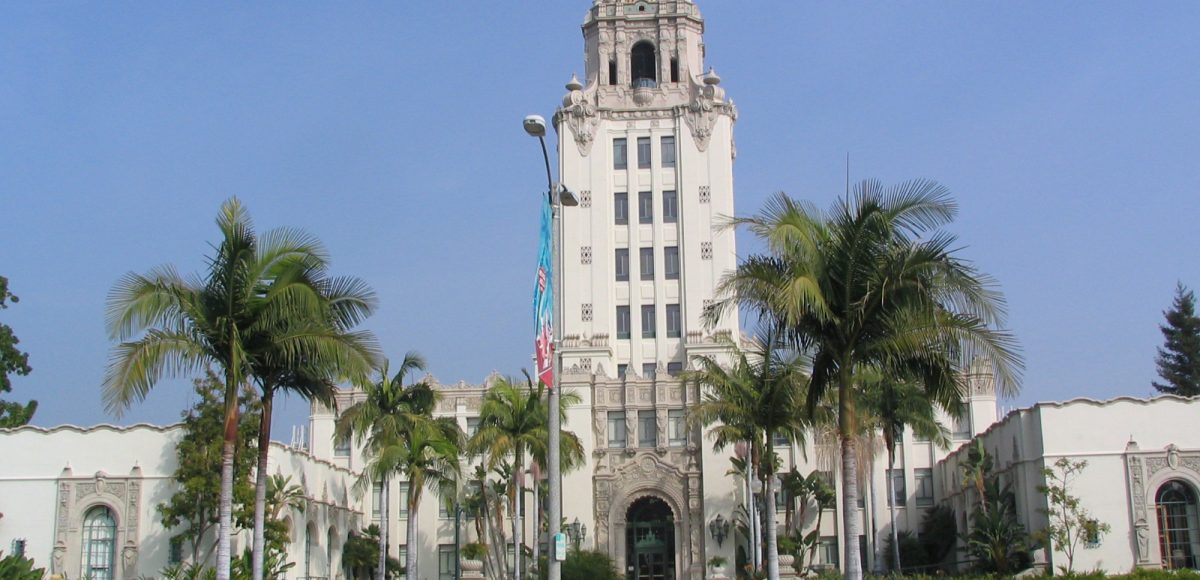The City Council discussed a bevy of issues at two public meetings on April 21 including initiatives enacted in response to the pandemic as well as regulations governing the use of face coverings in public.
“These are really difficult times and we are trying to make the best of it together,” said Mayor Lester Friedman.
Fines for Not Wearing Face Masks
People within the City of Beverly Hills will now face potential monetary fines for failing to wear a face covering if they have the potential of coming within six feet of someone who is not part of their household following passage of a revised urgency ordinance concerning COVID-19. The revised ordinance, which repeals its predecessor (Ordinance No. 20-0-2806), makes five substantive changes to the urgency ordinance originally passed on March 16, including adding a section on face coverings.
On April 10 the City issued an order requiring people to wear some type of face covering, such as a mask, scarf, bandana or cloth in an effort to promote public health and reduce the spread of COVID-19. The order originally mandated that everyone, including essential workers, wear face coverings when they leave their place of residence, including for walks through the neighborhood. The revised order now in place has it so that people must only wear masks when they have the potential to come within six feet of someone other than a member of their household. The penalty for not wearing a face covering is an administrative citation which carries a fine of $100 for the first offense, $200 for the second offense, and $500 for the third and subsequent offenses.
“There is widespread lack of compliance. It is really clear that maybe half the people out there are not complying with the mask ordinance,” said Councilman Julian Gold, M.D.
Both the Centers for Disease Control (CDC) and the Los Angeles Department of Public Health recommend wearing face masks when out in public to help prevent the spread of droplets that might be infectious. “It is absolutely critical that the City does everything possible to slow the pace of community spread and avoid unnecessary strain on our medical system,” states the revised ordinance, which passed with a 5-0 vote. The ordinance contains several exceptions for face coverings, including an exemption for children under the age of two from having to wear them.
Additional Health-related initiatives
Beginning the week of April 26, the City’s Nurse Practitioner Program will be able to test people exhibiting symptoms of COVID-19 while at home. “If anybody has symptoms, we’ll be able to do that and we’ll be doing that through our Nurse Practitioner Program,” confirmed Beverly Hills Fire Chief Greg Barton. Since the outbreak, all EMS callers are screened for signs and/or symptoms of COVID-19. Throughout the City, signs affixed to approximately 200 pedestrian pushbuttons at intersections instruct pedestrians to “not push the button.”
Rodeo Drive Podcast
The Council approved an expenditure of $40,000 to create a podcast series entitled “Only On Rodeo Drive.” The eight-episode podcast series will launch in tandem with the reopening of Rodeo Drive boutiques. Each 30-minute episode will explore luxury and fashion on Rodeo Drive. Rodeo Drive Committee past president Kathy Gohari told the Council the podcast series will help support efforts to revitalize Rodeo Drive once the street re-opens for business by bringing in new interest and customers to the stores and the City.
Walking in the Street
A proposal by Vice Mayor Bob Wunderlich to repurpose travel lanes for walkers and bicyclists in response to the COVID-19 pandemic and social distancing guidelines failed to gain traction with his fellow Councilmembers. According to a staff report, Los Angeles drivers are averaging speeds 12 percent faster during this time, with some driving as much as 25 percent faster. “Repurposing some traffic lanes would allow greater distance between the people who are walking,” Wunderlich said. “This is to take advantage of an opportunity that we have in front of us and to mitigate some of the problems we have with the speeding cars.”
Other members of the Council voiced concern that further opening up the streets to pedestrians and bikers would send a “mixed message” that in turn might create more congestion for active transportation modes. “My concern is that we’re going to encourage more people to come out,” Councilwoman Lili Bosse said.
Fiber to the Premises
Roughly 20 percent of the City is set to get faster Internet after the Council unanimously agreed to move forward with its Fiber to the Premise (FTTP) Project. Work had already begun on the project last year, but the Council needed to approve additional contracts valued at $4 million in order to continue the work. Contractors will lay an estimated 100 miles of fiber optic cable, linking homes and businesses using both aerial and underground construction. “Aerial construction phases will take approximately 12-14 months. With 9 to 11 aerial phases remaining, implementation may take five to 12 years,” the staff report states. A Council ad hoc committee had recommended that work stop on the FTTP project immediately due to the fact that the alpha phase was already beyond budget and given the lengthy timeline. A suggestion by Councilman Julian Gold to further review the project in a study session before proceeding did not find support. Before the vote, Assistant City Manager Nancy Hunt- Coffey said: “The project is shovel ready. We’re ready to go as soon as funding becomes available.”







